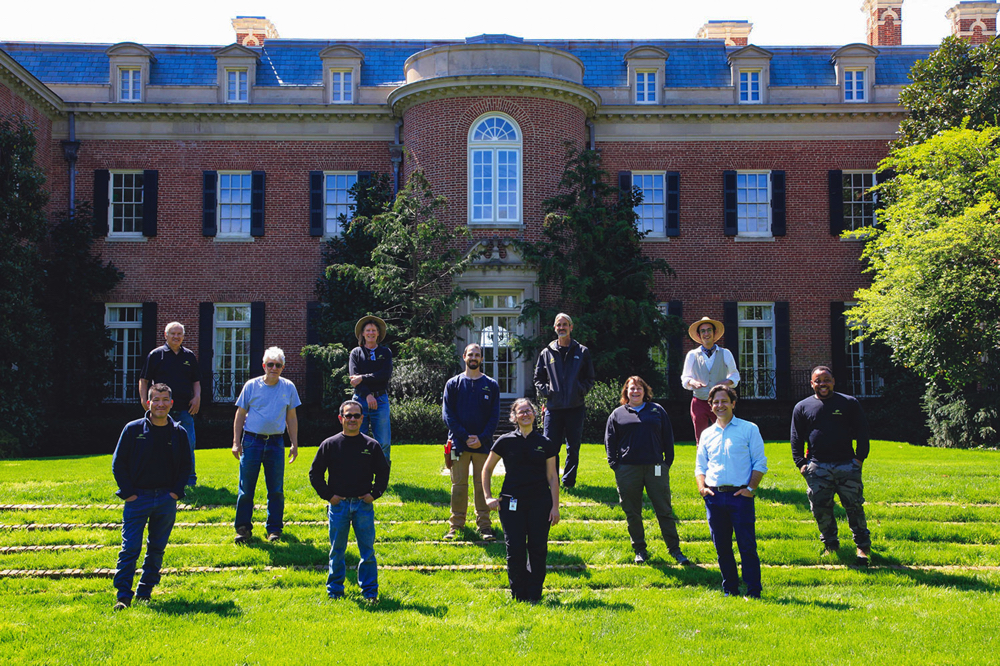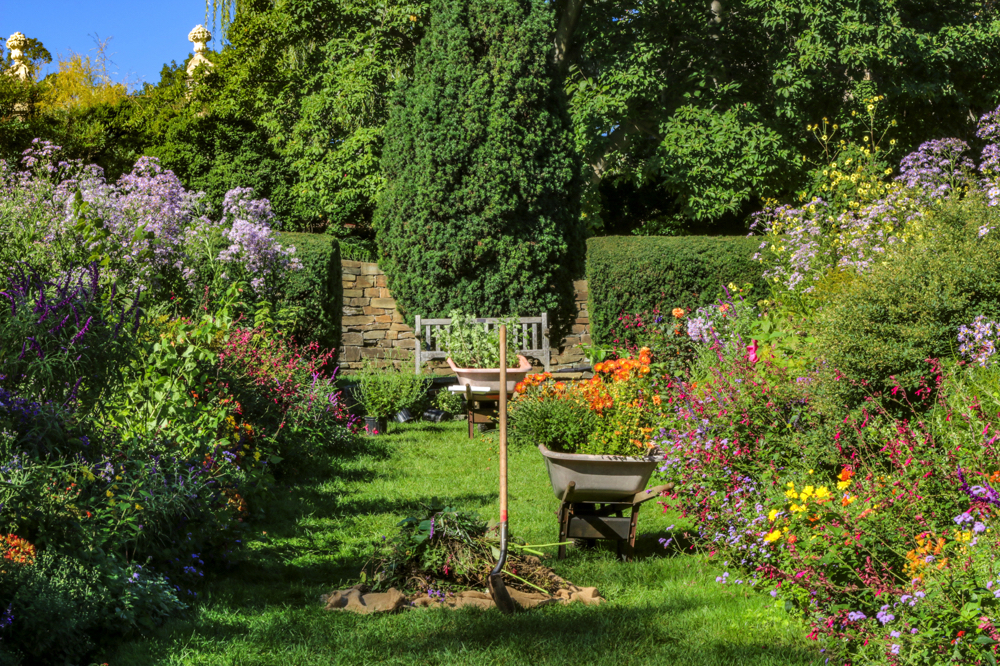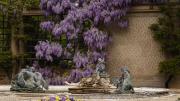This year marks one hundred years since Beatrix Farrand designed the gardens at Dumbarton Oaks Research Library and Collection, Harvard’s 16-acre research institution in Byzantine, Pre-Columbian, and garden and landscape studies tucked in the northern corner of Georgetown, Washington, D.C. The gardens boast exuberant blooms three out of the four seasons: each year the growing season tentatively emerges with tender crocuses and snowdrops before exploding into sumptuous wisteria, roses, peonies, and countless other blooms throughout late spring and summer. An heirloom chrysanthemum display ranging from rich scarlets and golds to pale pinks and lavenders closes out the flowering season come September.
The gardens, originally part of the 54-acre estate owned by Mildred and Robert Bliss, A.B. 1900, were designed by pioneering landscape architect Beatrix Farrand in close collaboration with Mildred Bliss. They first began designing the grounds in the summer of 1921, continuously adding and editing until the property was divided into donations to Harvard and the National Park Service in 1940. The 16 acres and neo-Georgian home that now comprise the research institution were the more formal gardens closest to the residence, falling away into less manicured bridle trails and woodlands to the north in what is now Dumbarton Oaks Park, farther from the house.
The residence now hosts the museum of Byzantine and Pre-Columbian art and other scholarly activities of the institution, and the formal gardens are open to the public six days a week, weather permitting. The garden designs and planting cycles retain almost entirely Farrand’s original midcentury designs as described in her Plant Book for Dumbarton Oaks, with some modifications by Farrand’s successor Ruth Havey, and for institutional use and public visitation. Just blocks from Georgetown’s commercial district and the Naval Observatory, Farrand’s purposefully winding paths and hidden views evoke a naturalistic, vintage-feeling oasis that belies the daily maintenance of the gardening team who preserve her vision throughout the year as a sustainable landscape for the twenty-first century.

The gardening staff in 2021
Photograph courtesy of Dumbarton Oaks Research Library and Collection
Visitors to the gardens enter through eye-catching wrought-iron gates on R Street that allow glimpses of the brick mansion, foregrounded by a curving gravel drive and expansive lawns. The east and south lawns are just a fraction of the territory maintained by Ricardo Aguilar together with gardeners Austin Ankers and Martin Nji. Within the landscape, the gardens are divided into three sections for maintenance, but their boundaries are loosely defined and fluid depending on the seasons and each crew’s needs. Aguilar’s team broadly covers the research institution’s private gardens and the public garden’s front lawns. “My focus is always on the front of the gardens,” explains Aguilar, “because it’s the first impression visitors have when they enter.” The team of three is a lean crew for an area that encompasses roughly six acres, but the key is working seamlessly and efficiently, especially when it comes to the turf. “They’ve worked it out that they can do almost all their mowing in one day,” says foreperson Marc Vedder—especially crucial during the growing season, when the lawns might need mowing twice a week to stay tidy and attractive to passersby.
After walking up the drive and through the enchanting Orangery—home to perhaps the oldest houseplant in North America, a Ficus pumila—visitors are led down to the most formal outdoor “room,” the Rose Garden. One of the Blisses’ favorite spots (their ashes are interred behind a Farrand-designed “finalities plaque” along the western wall), this garden boasts some 800 rosebushes arranged in geometric beds lined by flagstone paths, and is one of several flower-dense rooms in the eastern side of the property maintained by Rigoberto Castellon, who has been working at Dumbarton Oaks for nearly 35 years, and his crew. Though some bushes are likely more than 20 years old—since a renovation in the 1990s—plantings have come and gone, amid pest and disease pressures. One particularly devastating loss was an old white oak along the southern edge. The now heavily sun-exposed area is populated with a new rose variety, but the loss of the oak points to some of the longer-range challenges of the gardeners’ work.
“We’ve started losing large trees that we can’t really replace in our own lifetimes,” says Vedder, “so our challenge has been making choices now that will last down the road—we’re trying to invest in the future, just like people before us did.” To that end, several young trees “as close to the design intent” as possible, such as white oaks (Quercus alba), are being planted instead of red oaks that are susceptible to bacterial leaf scorch.

Herbaceous border
Photograph courtesy of Dumbarton Oaks Research Library and Collection
To the east of the Rose Garden, the boxwood-lined Box Walk forms a central north-south axis of the gardens and gracefully navigates a 40-foot drop in elevation. Here, the American and English boxwoods Farrand called for in her original designs are prone to the boxwood blight fungus, which has necessitated balancing historic design against twenty-first-century sustainability. “Plants in a historical context like this are way more stressed than before,” says Vedder, “so they may need more inputs to maintain them.”
The old approach to managing the blight would have been to spray the area with fungicides every week, but eventually the fungus would become resistant. “It’s just not sustainable to keep planting American and English boxwood in Box Walk anymore,” said Jonathan Kavalier, director of gardens and grounds, so the diseased bushes are being replaced with more blight-resistant boxwood cultivars, and fungicides are rotated to keep resistance to a minimum.
Box Walk also forms the eastern edge of the area cared for by the third crew, led by Walter Howell, who oversees the iconic Pebble Garden and contemplative Ellipse. The Pebble Garden, so called for the Havey-designed pebble mosaic at the center, once served as a tennis court but today is a favorite among guests for the wisteria that cascade along the walls in the springtime. Wisteria—and other plants like the English ivy that is prevalent in this part of the gardens—grow ferociously, especially in wet growing seasons, so pruning the vines and collecting seedpods later in the year to prevent further spread is a continual task. But there is a particular satisfaction to the frequent pruning and weeding for Howell, who often refers to the meditative and vital nature of plant maintenance. “Gardens, if they’re going to last for a hundred years, need gardeners,” he says. “We’re constantly balancing one plant against another to try and keep the artistic effect.”
Just before the transition into the woodlands of the park is the Ellipse, a room redesigned in the 1960s to encircle a Provençal fountain with Havey-designed benches and a ring of trees trimmed into a hedge, elevated on bare trunks, that begins eight feet aboveground. The Ellipse was renovated—literally from the ground up—in 2019 which, in addition to improving the overall health of the plants, has engendered shifts in gardening and maintenance practices throughout the gardens. Seventy-six newly trained American hornbeams were placed into soil engineered just for those trees with the help of Eric T. Fleisher, who has also revamped soils in Harvard Yard and the Arnold Arboretum. “We’ve been paying a lot more attention to soil biology since that project,” says Howell. “It’s good for the health of the plants to be thinking from the soil up,” especially with the disturbed soils that prevail in the terraced rooms. With the help of house-brewed compost tea that Kavalier and his team assess for diversity with a microscope before applying, the soil is now rife with microbes and nematodes to better support nutrient cycling and the natural defenses of the trees, shrubs, and other plantings.
The lush greenery and romantic ornaments of the gardens at Dumbarton Oaks are a living work of art amid a broader urban landscape, and face the same environmental challenges as any other site today. The gardeners, many of whom have worked in and observed this landscape for decades, have seen the global effects in the gardens in recent years. Warm winters have disrupted typical off-season pruning schedules; hardiness zones shifting northward have made the environment untenable for certain trees and brought new and ever-changing pest pressures. Confronting those challenges sustainably and responsibly while honoring the historic design is the priority for the gardeners of Dumbarton Oaks. Kavalier and the gardners have particularly focused on making plant choices that support the local ecosystem, using native replacements that are nevertheless reflective of Farrand’s design intent. “What we do as gardeners,” Howell reflects, “falls in the realm of design as much as it does of standard garden maintenance. We get to make small, daily decisions that add up to the powerful piece of art it is to walk through.”









